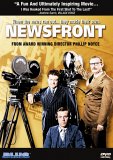Phillip Noyce’s critically acclaimed Newsfront comes to DVD from Blue Underground in a quite impressive package. While not always exciting, Newsfront does manage to attract attention, and is pieced together very well. It’s also a film covering unique material I am not sure has ever been covered in the realm of cinema.
The plot centers around Len, a newsreel photographer, who manages to keep audiences apprised of world events long before the nightly news ever exists. Len shoots films of any newsworthy item his employers at Cinetone can find for him. His footage is then used in theater houses throughout the country in an effort to inform, and sometimes entertain, the public. But heavy competition lurks ahead in the new invention of television. And Len is “a bit old fashioned,” as colleague Amy (Wendy Hughes) refers to him, so his survival in this new world could be endangered by the competition, which includes his opportunistic brother Frank (Gerard Kennedy). Frank, also a skilled newsreel photographer, wants to change with the times to insure his survival, so he heads for America, where he finds success in television. He would like to bring his brother along for the ride, but Len is an unchanged man in a quickly changing time. As things go, Len would rather be true to himself and what he’s always been, because he believes in it. And if that means he must give way, then so be it. But he’s not about to let life run right over him. And he won’t go down without a fight.
The film also contains interesting arguments as to how important it is to remain free, even if that means giving those against democracy a right to speech. A recurring theme in the picture is how Australia’s government seeks out Communism in a search-and-destroy effort. While Len is old-fashioned and very conservative to change, he also vehemently opposes the country’s efforts to stifle the Communist party. While he doesn’t agree with the conflicting viewpoint to democracy, he still protests, “I am a Democrat,” and that’s why he feels he must vote against the potential call-to-arms against those with whom he disagrees. So in a sense, the picture states through Len’s character that sometimes an unwillingness to change is a good thing. Because clearly, all change is not for the best.
With how popular newsreel footage used to be, it is remarkable the plight of the newsreel photographer never became a subject of interest in the motion picture industry until this 1978 effort. Also remarkable is that it took an Australian filmmaker such as Noyce, and the original script of Bob Ellis, to realize the subject’s full potential. While the material may be of greater interest to Australian citizens, as many local historic twentieth century events are covered and/or recreated in the two-hour running time, the film oozes a quality reminiscent of some of the era’s finest pictures. Though the subject matter greatly varies, the style of filmmaking calls to memory other great films such as Chariots of Fire, Ragtime, The Sting, and Network.
Video
Rarely does this nearly 30-year old film show its age. Presented here in a 1.78:1 anamorphic widescreen picture, the frame remains sharp and constant. Both the extensive black-and-white footage and the rich color portions are rendered with only an occasional artifact. The restoration falls short of perfect, but not by much. You definitely know you’re watching a DVD.
Audio
The Dolby Digital 5.1 presentation comes as close to perfection as the picture. The film’s major setpiece (a terrific, and expertly recreated flood) starts at one end of the room and flows nicely to the other. Dialogue is also in harmony with the volume.
Special Features
The two most interesting pieces of bonus material are the audio commentary and the 1978 Australian Film Awards excerpts. Both features touch on the hostility, which remains to this day, between original screenwriter Bob Ellis and director Phillip Noyce. Both men apparently differed on their viewpoints towards Communism. When Noyce’s rewrites included what Ellis deemed a more liberal outlook on the matter, he renounced the entire picture. I do wish more had been offered, such as extensive interviews between the two men. Perhaps a reunion.
Other features include: The Last Newsreel short subject, the original theatrical trailer, The NEWSFRONT Story featurette, and several DVD-ROM Bonus Features, which include, among other things, an in-depth selection of Newsfront reviews.
Final Thoughts
Newsfront is sometimes funny, sometimes tragic. It has a slow, methodical pace, but it still manages to be a charming film in spite of its few technical flaws. It’s a forgotten classic, well worth a look, and kudos to Blue Underground for deviating from their normal release material to remind the world of this film’s significance.





